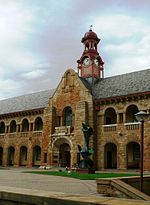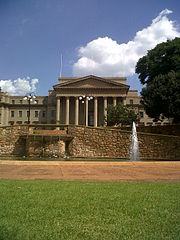Related Research Articles

Gauteng is one of the nine provinces of South Africa. The name in Sotho-Tswana languages means 'place of gold'.

The University of the Witwatersrand, Johannesburg, is a multi-campus South African public research university situated in the northern areas of central Johannesburg. It is more commonly known as Wits University or Wits. The university has its roots in the mining industry, as do Johannesburg and the Witwatersrand in general. Founded in 1896 as the South African School of Mines in Kimberley, it is the third oldest South African university in continuous operation.

The Vredefort impact structure is the largest verified impact structure on Earth. The crater, which has since been eroded away, was around 180–300 km (100–200 mi) across when it was formed. The remaining structure, comprising the deformed underlying bedrock, is located in present-day Free State province of South Africa. It is named after the town of Vredefort, which is near its centre. The structure's central uplift is known as the Vredefort Dome. The impact structure was formed during the Paleoproterozoic Era, 2.023 billion years ago. It is the second-oldest known impact structure on Earth, after Yarrabubba.

The Vaal Triangle is a triangular area formed by Vereeniging, Vanderbijlpark and Sasolburg about 60 km south of Johannesburg, South Africa. The area forms a substantial urban complex. Meyerton, just north of Vereeniging, is also sometimes included in the complex, and residents of Sharpeville, Boipatong, Bophelong, the greater Sebokeng area, Three Rivers, Heidelberg, Deneysville and Potchefstroom also generally tend to consider themselves to live in the Vaal Triangle. The area straddles the Vaal River and is a major industrial region, which is home to former Iron and Steel Corporation Iscor, now ArcelorMittal South Africa, and Sasol, respectively the steel and petrochemical processing facilities.
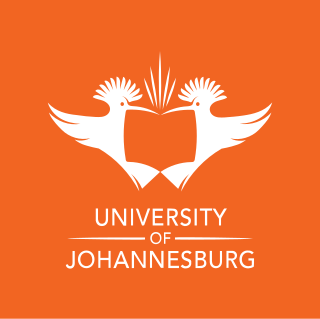
The University of Johannesburg (UJ) is a public university located in Johannesburg, South Africa. The University of Johannesburg came into existence on 1 January 2005 as the result of a merger between the Rand Afrikaans University (RAU), the Technikon Witwatersrand (TWR) and the Soweto and East Rand campuses of Vista University. Prior to the merger, the Daveyton and Soweto campuses of the former Vista University had been incorporated into RAU. As a result of the merger of Rand Afrikaans University (RAU), it is common for alumni to refer to the university as RAU. The vice-chancellor and principal of UJ is Professor Letlhokwa George Mpedi who took office on 1 January 2023. Between 2018 and 2022, UJ's vice-chancellor and principal was Tshilidzi Marwala.
The Southern Education and Research Alliance (SERA), founded in 1999, is a strategic alliance formed between the University of Pretoria and the Council for Scientific and Industrial Research. The alliance collaborates locally and internationally with universities, NGO's, companies and multinational bodies in various research areas. Sera has a 50% shareholding in the Innovation Hub, a fully accredited technology park situated on 60 hectares of the university's experimental farm.
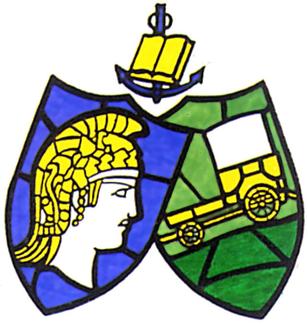
Transvaal University College was a multi-campus public research university in South Africa which gave rise to the University of the Witwatersrand and the University of Pretoria.
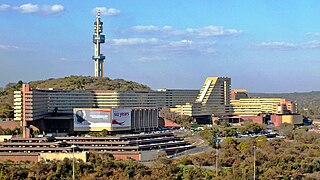
The University of South Africa (UNISA), known colloquially as Unisa, is the largest university system in South Africa by enrollment. It attracts a third of all higher education students in South Africa. Through various colleges and affiliates, UNISA has over 400,000 students, including international students from 130 countries worldwide, making it one of the world's mega universities and the only such university in Africa.
Elsayed Elsayed Wagih PhD, DIC, CIDTT is an Egyptian professor of virology and biotechnology and vice President of the Arab Society for Biotechnology. He was born in Alexandria, Egypt. Wagih is well known for having invented Zymoblot, the fastest available microtechnique to detect gene expression and/or enzyme activity in any biological specimen as well as the ”Mirror Image in vivo electro-blotting technique” that detects virus particles or any foreign protein in any tissue. He also discovered two viruses reported under his name in the world data bank of viruses, the first was named "Peanut Chlorotic Ringspot Virus (PCRV)" and the second was called “Peanut Top Paralysis (PTPV)".

SANReN is the project to create a new National Research and Education Network in South Africa. However, unlike most other NRENs, SANReN will provide its clients with both connectivity to the world's research networks as well as commodity Internet access.
The Council for Scientific and Industrial Research (CSIR) is South Africa's central and premier scientific research and development organisation. It was established by an act of parliament in 1945 and is situated on its own campus in the city of Pretoria. It is the largest research and development (R&D) organisation in Africa and accounts for about 10% of the entire African R&D budget. It has a staff of approximately 3,000 technical and scientific researchers, often working in multi-disciplinary teams.

The University of Pretoria is a multi-campus public research university in Pretoria, the administrative and de facto capital of South Africa. The university was established in 1908 as the Pretoria campus of the Johannesburg-based Transvaal University College and is the fourth South African institution in continuous operation to be awarded university status. The university has grown from the original 32 students in a single late Victorian house to approximately 53,000 in 2019. The university was built on seven suburban campuses on 1,190 hectares.

Fulufhelo Vincent Nelwamondo (OMS) is an electrical engineer by training, and holds a PhD in Electrical Engineering from the University of the Witwatersrand, in South Africa. He is the youngest recipient of the Harvard-South Africa Fellowship Programme amongst other honours. His research and practical experience has covered a wide spectrum of areas, including software engineering and computational intelligence. His interests include biometrics-based systems, data mining and machine learning tools.
Sushil Kumar was an Indian geneticist and academic, known for his Plant and microbial genetical genomics, especially the studies on Escherichia coli and Lambda phage as well as on the mutants of Rhizobium. He was a former director of the Central Institute of Medicinal and Aromatic Plants of the Council of Scientific and Industrial Research and an elected fellow of the Indian National Science Academy, National Academy of Agricultural Sciences, National Academy of Sciences, India, and Indian Academy of Sciences. The Council of Scientific and Industrial Research, the apex agency of the Government of India for scientific research, awarded him the Shanti Swarup Bhatnagar Prize for Science and Technology, one of the highest Indian science awards, in 1981, for his contributions to biological sciences.
Michèle Ramsay is a South African Professor of human genetics at the National Health Laboratory Service and the University of the Witwatersrand. Ramsay's research has investigated single-gene disorders, epigenetics, obesity and hypertension. She was the President of the African Society of Human Genetics from 2014 until 2019.
Open access to scholarly communication in South Africa occurs online via journals, repositories, and a variety of other tools and platforms. Compared to other African nations, open access in South Africa has grown quickly in recent years.
Rachel Kerina Chikwamba is a Zimbabwean plant geneticist born in 1967. She is in the Council for Scientific and Industrial Research (CSIR) Group Executive: Strategic Alliances and Communication. She is an active member of the Academy of Science of South Africa.

Irvy (Igle) Gledhill is a South African physicist at the University of Witwatersrand, School of Mechanical, Industrial & Aeronautical Engineering, in Johannesburg.
Frances Gamble (1949–1997) was a South African climatologist and speleologist. Her work on cave conservation was extensive and pioneering. She evaluated cave ecosystems and conservation policies which were necessary to protect them. Gamble was one of the founders of the Cave Research Organisation of South Africa, which aimed at improving the scientific and professional development of speleology in South Africa. She was president of the Environmental Education Association of South Africa from 1986 to 1989 and of the South African Geographical Society from 1989 to 1991. At a time when Apartheid limited collaboration for South African researchers, she built networks internationally to facilitate research.
References
- ↑ Profiles [ permanent dead link ] African Centre for Gene Technologies
